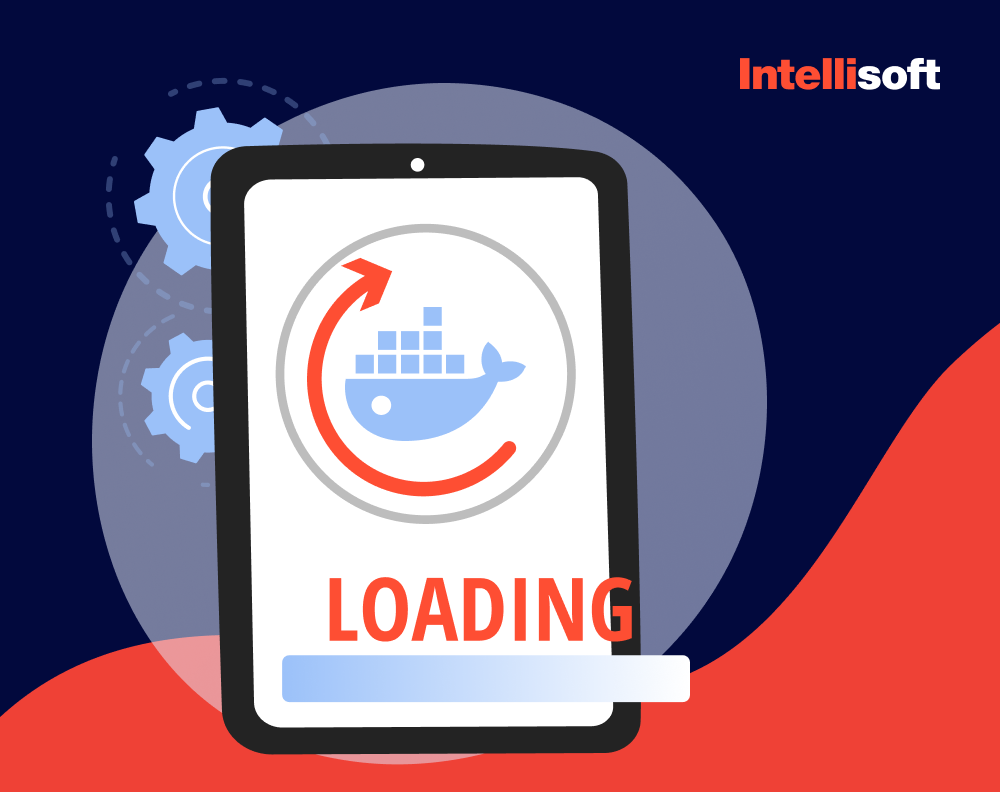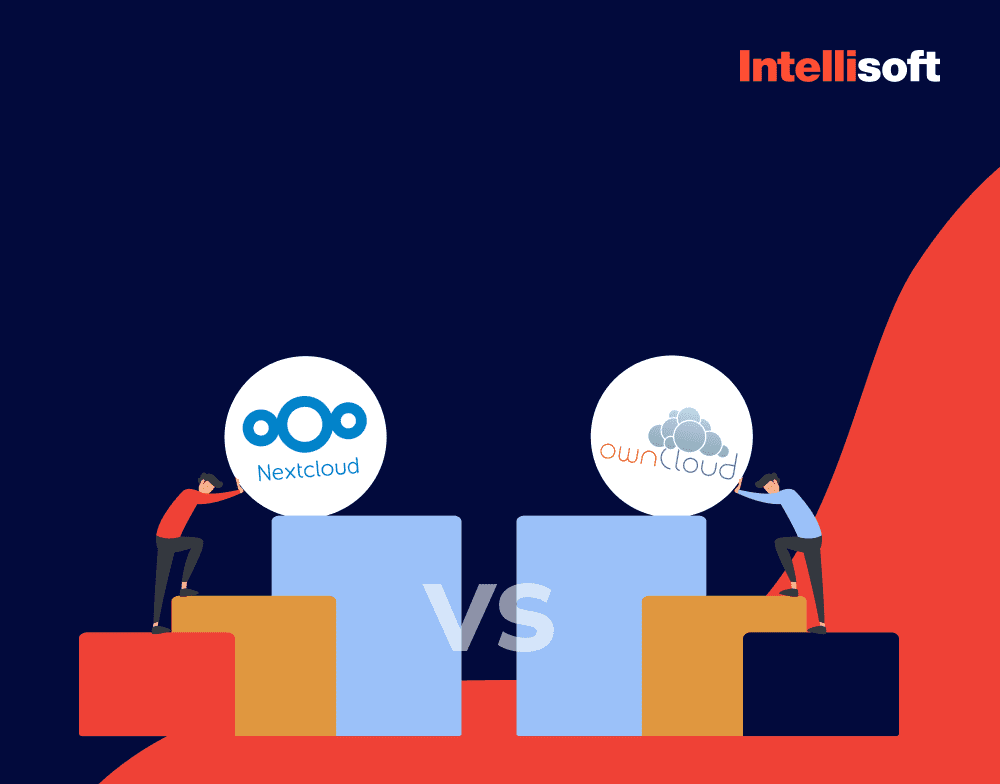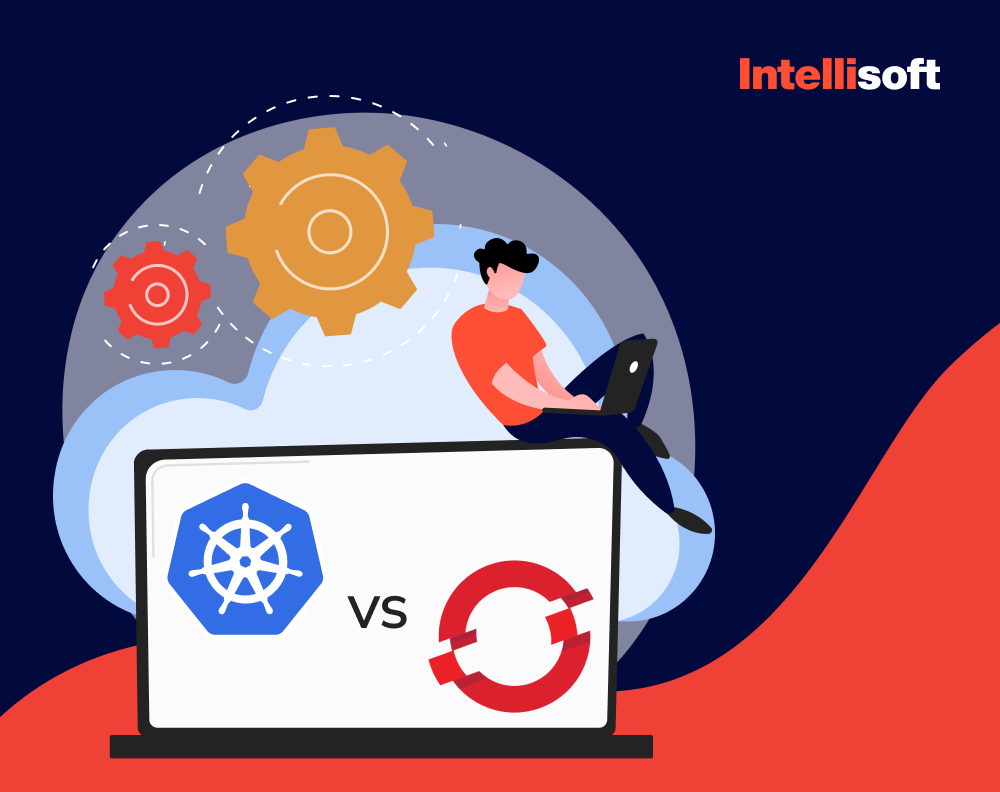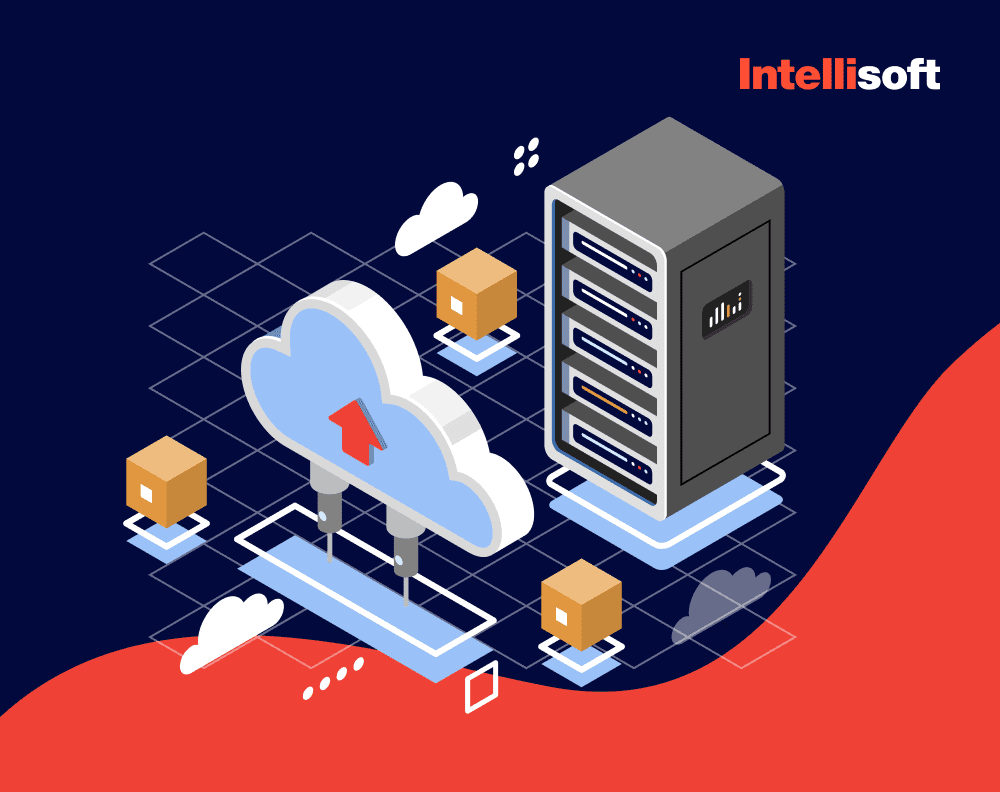Imagine this: You’re sitting on a mountain of data, but every time you try to make sense of it, you’re met with slow queries, outdated reports, and a headache from managing multiple platforms. You know your data holds the key to better decisions, but it feels like an untamed beast that refuses to be tamed. Sound familiar?
This is where Snowflake Data Warehouse steps in – a cloud information warehouse designed to simplify and supercharge your data operations. But with so many promises from different tools, how do you cut through the noise to find the solution that truly works for you?
At IntelliSoft, we’ve spent 15 years helping businesses just like yours navigate the complex world of data management. We’ve seen firsthand the frustration of battling inefficiencies, and we know the relief that comes when you finally find a tool that just works.
In this article, we’ll answer the question, “Is Snowflake a data warehouse?” and explain why Snowflake could be the game-changer you’ve been searching for and how our expertise can help you unlock its full potential. Ready to transform your information into your greatest asset? Let’s get started.
Table of Contents
Data Warehousing in a Nutshell
The essence of a data warehouse (DW) lies in its ability to integrate information from multiple, often disjointed, sources – whether it’s Customer Relationship Management (CRM) systems, Online Analytical Processing (OLAP) or Online Transaction Processing (OLTP) databases, or various enterprise applications.
What Is Data Warehouse Used For?
Why use snowflake data warehouse? An information warehouse is a cornerstone of modern data management, serving as the foundation upon which businesses build their data-driven strategies. Its significance goes beyond mere storage – it transforms raw information into a powerful asset that drives business intelligence, operational efficiency, and strategic decision-making.
Here’s what it is used for:
Historical Repository
DW pulls in information from all over – whether it’s sales figures, customer interactions, or website analytics – and stores it in one big, organized system. This makes it a breeze to look back at how things were last month, last quarter, or even last year. Need to generate a report on last year’s sales trends? Your information warehouse has got you covered, helping you see the big picture without digging through endless spreadsheets.
Query Execution and Processing Engine
Have you ever tried running a massive query on a regular database and ended up waiting forever for results? A data warehouse is designed to handle this kind of heavy lifting.
It’s like having a supercharged engine under the hood that can process huge amounts of data quickly and efficiently. Whether you’re trying to analyze customer behavior, forecast demand, or make real-time decisions, an information warehouse gives you the speed and power to get the answers you need without the frustration of long waits.
But these are just the basics. An information warehouse can do so much more, from powering advanced analytics and machine learning models to helping you uncover hidden patterns in your information.
Text: Hire experienced data analysts
CTA: Learn more
Link: https://intellisoft.io/data-analytics-services/
Components Of A Data Warehouse
A data warehouse is more than just a repository for information; it’s a sophisticated system with multiple components working in harmony to ensure information is collected, stored, processed, and analyzed effectively. Let’s dive deeper into the core components that make an information warehouse function smoothly and create data warehouse in Snowflake.

Data Sources
Data warehouses pull information from various information sources, which could include operational databases, CRM systems, ERP systems, flat files, and external information sources. The diversity of these sources ensures that the warehouse captures a holistic view of an organization’s data, but it also introduces the complexity of integrating different formats, structures, and types of information.
Data Extraction, Transformation, and Loading (ETL)
The ETL process is the backbone of a information warehouse. Here’s how it works:
- Extraction. Raw information is extracted from various source systems. This can be a complex task, especially when dealing with disparate information formats and large volumes of data.
- Transformation. The extracted information is then cleaned, filtered, and transformed into a consistent format. This step may involve converting information types, removing duplicates, and applying business rules to ensure the information meets the warehouse’s standards.
- Loading. Finally, the transformed data is loaded into the information warehouse. This can be done in batches or in real-time, depending on the needs of the organization.
The ETL process is crucial because it ensures that the information entering the warehouse is accurate, reliable, and ready for analysis.
Data Storage
Once the information is loaded into the warehouse, it is stored in a way that optimizes it for querying and analysis. Data storage in a warehouse is typically organized into tables, partitions, and indexes, which help improve query performance and information retrieval times. Depending on the warehouse, it can support structured information (like relational databases), semi-structured information (like JSON, XML), and even unstructured information (like text and multimedia files).
Metadata
Metadata is the information about the information. It provides context, making the information within the warehouse understandable and accessible. Metadata includes information such as information definitions, source mappings, and transformation rules. This component is essential for ensuring that users can trust the information they’re working with, as it documents how the information was processed and where it originated.
Data Management
This component involves the processes and tools used to manage, monitor, and maintain the data warehouse. It includes tasks like information backup, archiving, performance tuning, and monitoring to ensure that the information warehouse operates efficiently and securely.
Query Tools and Data Access
The ultimate purpose of a data warehouse is to provide users with quick and easy access to data for reporting and analysis. Query tools can range from simple SQL interfaces to more advanced analytics platforms that offer drag-and-drop functionality, information visualization, and machine learning capabilities.
Data Marts
Data marts allow for more efficient information access by isolating relevant data for a particular group, reducing the complexity and size of queries. They can be either dependent (created directly from the information warehouse) or independent (sourced from various information systems directly).
Data Warehouse Architecture
The architecture of an information warehouse can vary depending on the needs of the organization. Common architectures include:
- Single-tier. Combines all components into one layer, which is less common due to limited scalability.
- Two-tier. Separates information storage and processing layers but may suffer from performance bottlenecks.
- Three-tier. The most common architecture, which includes a bottom tier for the database, a middle tier for the ETL and processing, and a top tier for query tools and analytics.
Data Warehouse VS Database
Is Snowflake a database or data warehouse? Let’s explore the difference.
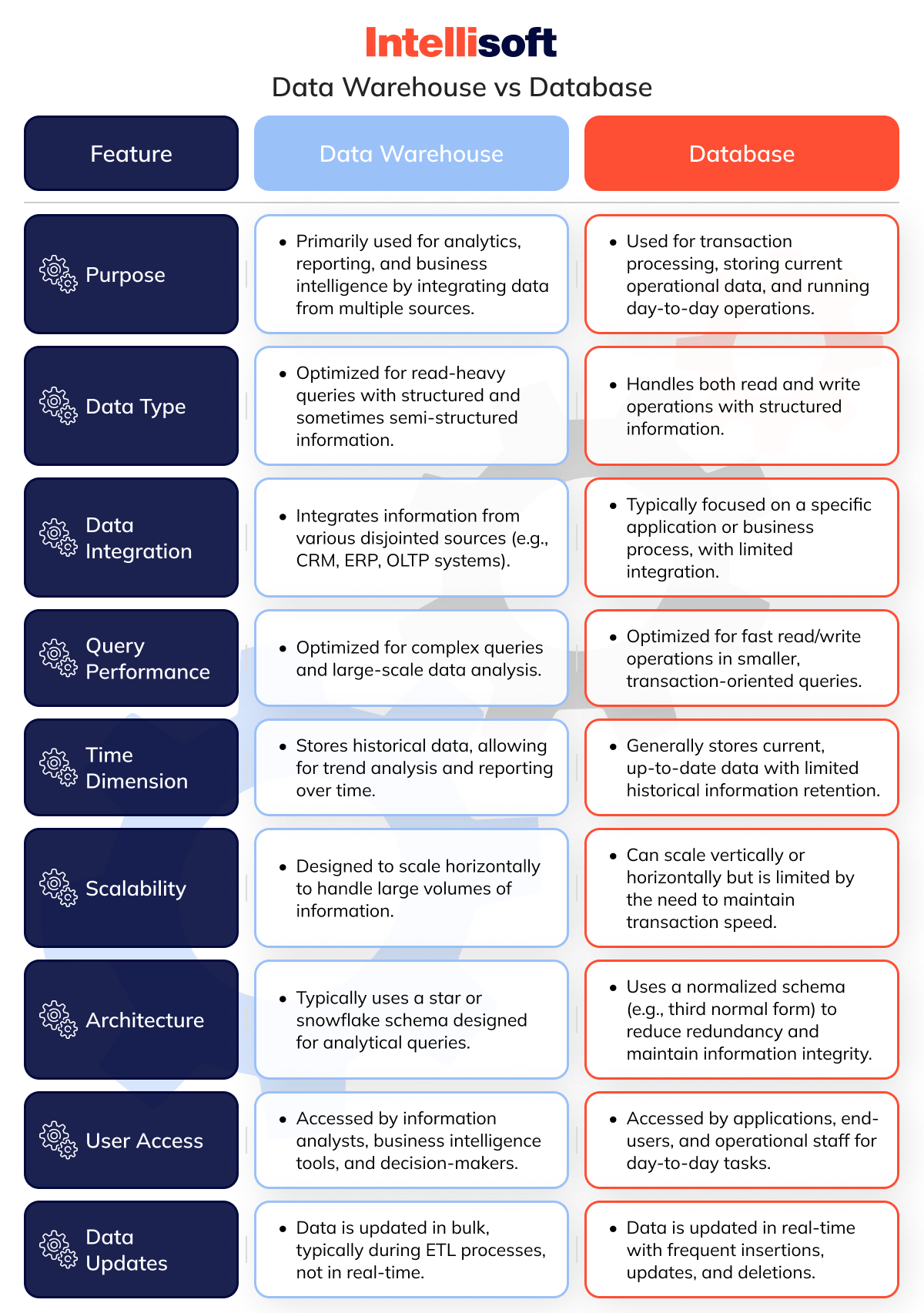
Data Warehouse VS Data Lake
Let’s see the difference between Snowflake data lake vs data warehouse.

What Is Snowflake Data Warehouse?
Is Snowflake a data warehouse? The short answer is – yes.
Picture this: a data platform that feels like a breath of fresh air in the crowded world of information management. That’s Snowflake cloud data warehouse for you.
It’s not just another tool; it’s a game-changer that makes handling information as straightforward as a Sunday morning.
Bob Muglia, former CEO of Snowflake, said in 2017, “Snowflake’s built-for-the-cloud architecture has dramatically changed the way organizations do business by helping them harness all of their information in a powerful, flexible, affordable way.”
Snowflake Data Warehouse integrates information warehousing, analytics, and sharing into one sleek package, eliminating the need to manage multiple tools and clunky interfaces. The data warehouse snowflake schema is designed to transform chaotic information into a well-organized treasure trove ready to deliver insights and spark innovation.
How Does Snowflake Data Warehouse Work?
What is Snowflake schema in data warehouse? Snowflake’s brilliance lies in its ability to separate compute from storage, a bit like having separate rooms for cooking and dining.
This separation means you can scale your computing power and storage independently, ensuring smooth performance no matter how big your information gets. When you upload data to Snowflake in data warehouse, it’s automatically organized and optimized, so you don’t have to lift a finger.
The Snowflake schema in data warehouse is smart enough to handle multiple users and queries at the same time without breaking a sweat.
What Makes Up the Snowflake Platform?
Data warehouse migration to Snowflake is built around three key components, each bringing its own set of strengths to the table. These components work together to create a seamless and efficient data management experience. Here’s a comprehensive Snowflake data warehouse tutorial:
Cloud Services
Imagine Cloud Services as the command center of data warehouse Snowflake platform. It’s where all the behind-the-scenes action happens. With the power of ANSI SQL, Snowflake data warehouse services help users optimize their information and manage their infrastructure effortlessly. This component handles a range of tasks – everything from authentication and infrastructure management to query parsing and optimization. It also ensures that your information is secure, using robust encryption and meeting rigorous standards like PCI DSS and HIPAA. Think of Cloud Services as the backbone of Snowflake, managing information security and infrastructure with a deft touch.
Query Processing
When it comes to analyzing information, the Query Processing component – also known as the compute layer – is where the real action takes place. This part of Snowflake is made up of virtual cloud information warehouses. Each of these warehouses operates as an independent cluster, which means they don’t compete for computing power or affect each other’s performance. This design ensures that your information analysis runs smoothly and efficiently, even when multiple tasks are happening at the same time. Picture each virtual warehouse as a dedicated workspace, where data processing occurs without interruptions or slowdowns.
Database Storage
Finally, there’s Database Storage – the component that keeps your information organized and ready for action. In this layer, Snowflake handles everything related to storing and processing your information. Whether it’s structured or semi-structured, Snowflake’s databases manage it all, taking care of organization, structure, metadata, file sizes, compression, and more. It’s like having a smart filing system that automatically takes care of all the nitty-gritty details, so you don’t have to worry about the intricacies of information management.
Snowflake Data Warehouse Architecture
Think of Snowflake data warehouse design as a well-oiled machine with three distinct but interconnected layers, each playing a crucial role in the platform’s efficiency and performance. What is snowflake cloud data warehouse made of?

Data Storage Layer
At the heart of Snowflake’s architecture is its Data Storage Layer, where your data finds its home. This layer handles both semi-structured and structured information seamlessly, and even has the capability to manage and process unstructured information. Snowflake takes care of the entire information storage process—from managing file sizes and metadata to handling information compression and organization. It’s like having a smart librarian who not only stores your books but also organizes them in a way that makes retrieval quick and easy.
Query Processing (Compute) Layer
Next up is the Query Processing or Compute Layer. This is where the real magic happens. Snowflake’s compute resources, known as virtual cloud warehouses, operate independently as separate clusters. This design ensures that different tasks don’t step on each other’s toes, preventing conflicts over computing resources. It also means that performance remains stable, even when multiple users are querying information simultaneously. Essentially, it’s like having multiple chefs working in their own kitchens—each focused and undisturbed, ensuring that every dish (or information query) is prepared efficiently.
Cloud Services (Client) Layer
Finally, there’s the Cloud Services Layer, which acts as Snowflake’s command center. This layer operates using ANSI SQL, allowing users to manage and optimize their information infrastructure with ease. Security is a top priority here – Snowflake is a data warehouse that encrypts data both in transit and at rest, ensuring that your information is always protected. The platform also boasts certifications like HIPAA and PCI DSS, which means it meets rigorous standards for information security and privacy.
Snowflake Use Cases
Snowflake model data warehouse isn’t just a powerful platform—it’s a versatile tool that adapts to various needs, helping businesses tackle a range of information challenges. Let’s dive into some of the key ways Snowflake is making an impact:
Data Ingestion
Imagine seamlessly bringing all your information into one place without breaking a sweat. Snowflake makes information ingestion a breeze, handling everything from structured to semi-structured data. Whether you’re dealing with streaming information or batch uploads, Snowflake ensures that your information is ingested efficiently, organized neatly, and ready for analysis in no time.
BI and Analytics
For businesses that rely on Business Intelligence (BI) and analytics, Snowflake is a game-changer. It provides a robust environment for running complex queries and generating insightful reports. With its powerful compute capabilities, Snowflake helps turn raw data into actionable insights, enabling smarter decisions and uncovering trends that drive strategic initiatives.
Data Sharing and Collaboration
Gone are the days of clunky data sharing methods. Snowflake revolutionizes information collaboration by making it easy to share live information securely with partners, teams, or departments. This feature fosters better teamwork and ensures everyone has access to the latest information without the hassle of managing multiple information copies or dealing with security concerns.
Machine Learning (ML)
When it comes to Machine Learning, Snowflake shines with its ability to handle large datasets efficiently. It supports the loading, transforming, and managing of extensive information, making it a perfect fit for ML Snowflake data warehouse projects. Snowflake integrates seamlessly with popular machine learning libraries such as TensorFlow and PyTorch, and it even connects directly with Apache Spark.
This integration streamlines information preparation and facilitates the creation of sophisticated ML models. Plus, with support for programming languages like Python, R, Java, and C++, Snowflake gives users the flexibility to develop and deploy advanced ML solutions with ease.
What is Snowflake Data Warehouse Pricing Model?
Snowflake’s pricing model is as flexible as its platform, designed to fit various needs and budgets without unnecessary complexity. Rather than locking you into rigid plans, Snowflake offers a pay-as-you-go structure that lets you scale your costs in line with your usage, making it a great fit for startups or large enterprises.
Storage Costs
The first component of Snowflake’s pricing is storage. You pay for the space your information occupies, which is billed on a monthly basis. Snowflake’s storage is highly efficient, with built-in compression to help keep costs down. Whether you’re storing structured or semi-structured information, you only pay for the actual storage you use—no more, no less.
Compute Costs
Compute costs, the second key component, are where Snowflake truly shines in terms of flexibility. You’re billed based on the computing resources you use, measured down to the second. This means you only pay for the compute power you need when you’re running queries or processing information. Snowflake’s virtual warehouses can be scaled up or down depending on the workload, so you’re never overpaying for idle resources. It’s a pricing model that matches your needs as they grow or change, making it both cost-effective and scalable.
Additional Features
On top of storage and compute costs, Snowflake offers additional features and services that you can opt into, such as dedicated cloud services or enhanced security options. These are priced separately, allowing you to customize your package to include only what you actually need.
Related Readings:
- Things to Know About Data Processing Agreement (DPA)
- Legal Requirements for Storing Data: Key Insights for Storing User Data
- Making Sense of Databases: How to Choose the Right One
- Big Data Security Intelligence: What You Need to Know
- Machine Learning vs Predictive Analytics: How to Choose
Benefits of Snowflake Data Warehouse
With Snowflake, you get more than just a secure data warehouse; you get a high-tech security squad that’s always on the job, ensuring your information is safe, accessible, and ready for action. Let’s explore why snowflake data warehouse is a great choice for you:
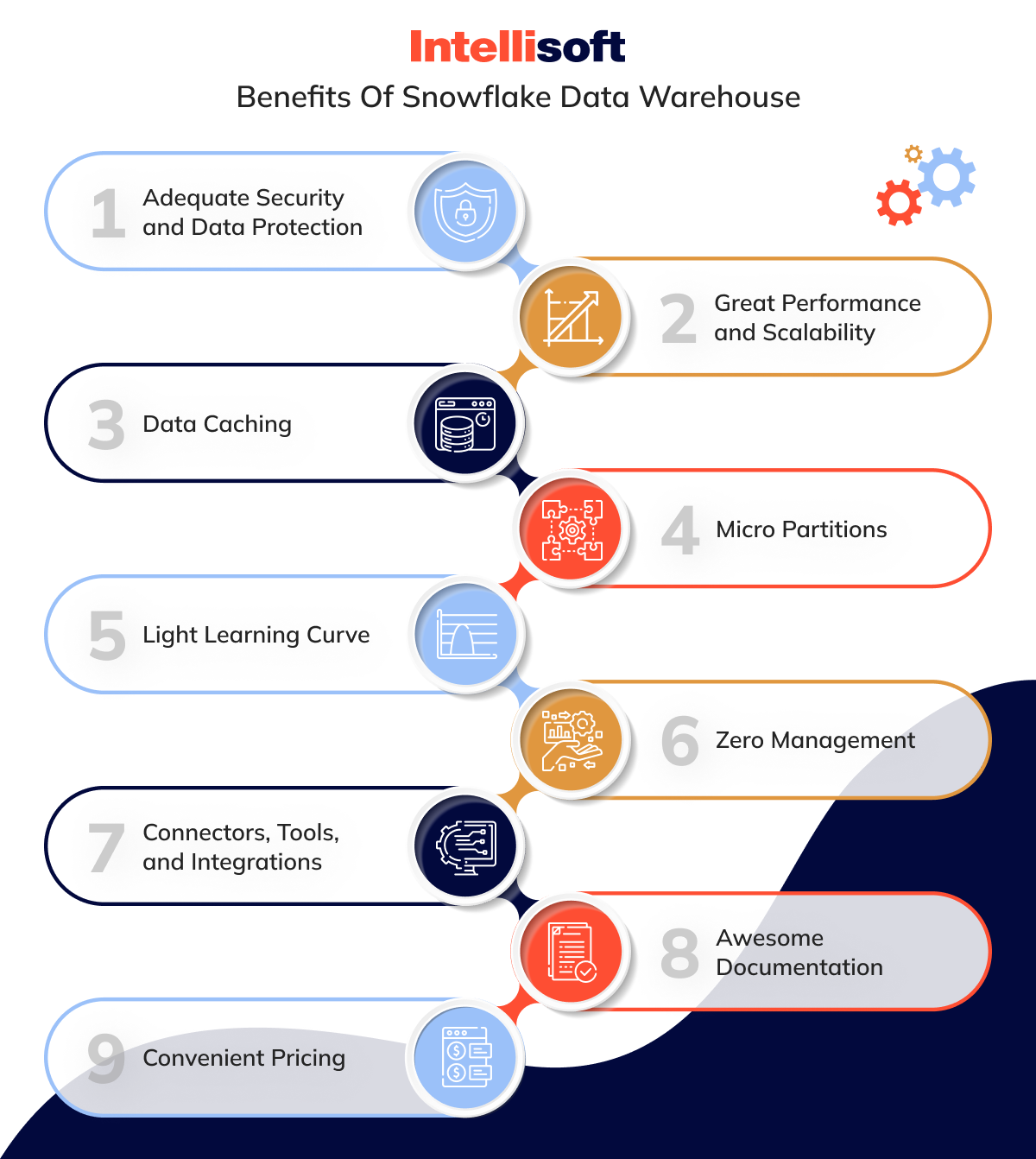
Adequate Security and Data Protection
When it comes to keeping your data safe, Snowflake doesn’t mess around. Picture a high-tech security system that not only locks down your information, but also keeps a sharp eye on every corner. That’s Snowflake’s approach – offering top-tier security features to make sure your information is always secure.
With Snowflake elastic data warehouse, you can pick specific regions for storing your data, meeting stringent regulations like HIPAA and PCI DSS. This means your information is not only locked up tight but also managed in line with the highest standards. You get customizable security settings to fit your needs, from regulating access to managing IP allowlists and blocklists.
Encryption is a cornerstone of Snowflake’s security strategy. Your information is encrypted both at rest and in transit, keeping it confidential and safe from prying eyes.
Snowflake also throws in some clever features like Time Travel and Fail-safe. Time Travel lets you rewind your information to any point in the past, perfect for undoing accidental changes. Enterprise users can extend this window up to 90 days. Fail-safe kicks in after Time Travel ends, giving you an extra 7 days to recover your information if needed – like having a safety net for your information.
Great Performance and Scalability
When it comes to crunching data, Snowflake is in a league of its own. Imagine a platform that can handle anywhere from 6 to 60 million rows of data in just 2 to 10 seconds. That’s the kind of speed Snowflake brings to the table, as benchmarked in tests using Tableau.
Snowflake’s impressive performance isn’t just about raw speed; it’s about delivering results with precision and efficiency. Whether you’re running complex queries or analyzing massive datasets, Snowflake ensures that your information processing is swift and seamless. This kind of performance means you spend less time waiting and more time making information-driven decisions.
So, if you’re looking for a data warehouse that combines lightning-fast speed with robust capabilities, Snowflake schema data warehouse performance is a game-changer. It’s designed to keep up with your information needs, no matter how large or complex, giving you the power to unlock insights and drive your business forward with unprecedented agility.
Data Caching
Snowflake’s data caching works behind the scenes to speed up data retrieval. It stores frequently accessed information in a quick-access memory, so when you need it again, it’s already ready to go. This means less time waiting for queries to run and more time diving into insights. Whether you’re running routine reports or delving into complex analyses, information caching ensures that Snowflake delivers results with impressive speed and efficiency.
Micro Partitions
One of the standout features of Snowflake is its use of micro-partitions – a clever approach to storing and managing data. Think of micro-partitions as the building blocks of Snowflake’s storage system. Each micro-partition is a continuous unit of storage that physically holds information, but with a twist: they’re designed to be small and efficient.
These “micro” partitions range in size from 50 to 500 MB before compression, making them the perfect size for quick access and optimal performance. The name “micro” reflects their compact size, but don’t let that fool you – they pack a powerful punch when it comes to information management.
What’s really impressive is how flexible these micro-partitions are. Snowflake handles resizing automatically, but users also have the option to adjust them as needed. This means that whether your information grows or changes, Snowflake can adapt on the fly, ensuring that your data remains well-organized and easily accessible.
Light Learning Curve
Snowflake is crafted with a focus on simplicity and accessibility, making it remarkably easy for users to start using the platform effectively. Its interface is designed to be intuitive, so you won’t need a PhD in information science to get things rolling. Imagine stepping into a well-organized library where every book is easy to find and every tool is clearly labeled. That’s what Snowflake feels like.
The platform’s architecture is straightforward, with a clean and user-friendly interface that demystifies complex information processes. Snowflake’s documentation and support resources are robust, offering plenty of guidance for new users. Interactive tutorials, helpful community forums, and in-depth guides ensure that you can quickly learn the ropes without getting lost in technical jargon.
Zero Management
One of Snowflake’s standout attributes is its commitment to “zero management,” which essentially means you can enjoy all the benefits of a powerful information warehouse without the usual administrative headaches. Picture a cutting-edge information platform that runs efficiently on autopilot – Snowflake is designed to be just that.
With zero management, Snowflake handles the heavy lifting of data operations so you don’t have to. Whether your information processing needs spike or dip, Snowflake seamlessly adjusts to keep things running smoothly.
The platform also takes care of maintenance tasks such as backups and performance tuning. Automated backups ensure that your information is consistently protected and recoverable, while built-in performance optimizations keep your queries fast and efficient. This means you’re spared from the usual routine of managing infrastructure, troubleshooting issues, or performing upgrades.
Connectors, Tools, and Integrations
Snowflake doesn’t just stand alone; it seamlessly integrates with a wide range of tools and technologies to make data management and analysis a breeze. Whether you’re a coder, a data scientist, or a business analyst, Snowflake’s extensive connectivity options ensure that you can work with your information in the way that suits you best.
Web UI and Command-line Interface
- Web UI. Provides an intuitive, user-friendly environment for managing information, running queries, and monitoring performance with ease.
- Command-line Interface. Offers advanced control and automation capabilities for those who prefer a script-based approach.
Connectors
- Python Connector. Ideal for developers creating applications that interact with Snowflake, facilitating smooth integration.
- ODBC Driver. Supports C and C++ development, allowing for direct connections between Snowflake and applications built in these languages.
- JDBC Driver. Connects Java-based applications to Snowflake, providing a robust link for Java developers.
Data Integration Tools
- Hevo Data. An official Snowflake ETL partner that offers a no-code pipeline to transfer data from various sources into Snowflake in real-time.
- Apache Kafka. Utilizes a publish/subscribe model for information streaming, with the Snowflake Connector for Kafka enabling efficient data loading from Kafka topics.
- Informatica Cloud and Informatica PowerCenter. Provide comprehensive cloud data management solutions that integrate seamlessly with Snowflake.
Awesome Documentation
Snowflake’s documentation is a standout feature, offering a user-friendly and thorough resource to guide you through every aspect of the platform. It simplifies complex concepts with clear, step-by-step instructions and interactive tutorials, making it easy to get hands-on experience. The extensive FAQs and troubleshooting sections address common issues, while the active community forum and responsive support team provide additional help. Overall, Snowflake’s documentation ensures you have the support you need, whether you’re a beginner or an expert.
Convenient Pricing
Snowflake’s pricing model is designed for flexibility and ease. With a pay-as-you-go approach, you only pay for what you use, avoiding upfront commitments and unexpected costs. The pricing is transparent, providing clear breakdowns of compute and storage costs. This model scales with your needs, allowing you to start small and grow as required. Whether you’re a startup or an enterprise, Snowflake’s pricing offers a cost-effective solution that adapts to your data requirements.
The Cons of Snowflake Data Warehouse
Even with all its shiny features, Snowflake isn’t without its flaws. Let’s dive into some of the downsides you might encounter.

On-Premises Storage
If you’re still interested in storing information on-premises, Snowflake might disappoint you. It’s a cloud-native platform through and through, meaning there’s no option for on-premises storage. While this cloud-only approach brings many benefits, it can be a deal breaker for those who require or prefer the control and security that on-premises storage offers.
On-Demand Pricing Can be Costly
Snowflake’s pay-as-you-go model is flexible, but it can also be a double-edged sword. If you’re not careful, those on-demand costs can quickly add up, especially with heavy or unpredictable usage. It’s like an all-you-can-eat buffet – you might not realize how much you’re consuming until the bill arrives.
Relatively Small Community
Compared to some of the giants in the tech world, Snowflake’s community is still growing. While it has a strong and supportive user base, it’s not as vast as some other platforms. This means fewer forums, less open-source tooling, and a smaller pool of community-generated resources. If you like to rely on community support and resources, you might find Snowflake’s relatively small community limiting.
Cloud-Agnostic Approach
Snowflake prides itself on being cloud-agnostic, working seamlessly across major cloud providers like AWS, Azure, and Google Cloud. However, this flexibility can be a bit of a curse if you’re looking for deep, specialized integrations with a specific cloud service. Snowflake’s broad compatibility might mean it lacks the fine-tuned optimizations you’d find in cloud-native solutions dedicated to a single provider.
Data Streaming
When it comes to real-time information streaming, Snowflake isn’t quite at the forefront. While it offers some capabilities, it lags behind other platforms designed specifically for high-speed data streaming.
Snowflake Alternatives
While Snowflake is a powerhouse in the world of cloud information warehousing, it’s not the only player on the field. Depending on your specific needs, several worthy alternatives might suit your data strategy better.
Amazon Redshift
Amazon Redshift is one of the most well-known information warehousing solutions and a direct competitor to Snowflake. Built on AWS, Redshift offers deep integration with other Amazon services, making it a strong choice for those already embedded in the AWS ecosystem. It’s fast, scalable, and, like Snowflake, operates on a pay-as-you-go model. However, Redshift requires more hands-on management, which might be a plus or a minus, depending on how much control you want.
Google BigQuery
If you’re living in the Google Cloud universe, BigQuery might be your go-to alternative. Google’s fully managed information warehouse is known for its lightning-fast SQL queries and ability to handle massive datasets with ease. It’s serverless, so there’s no need to manage infrastructure, and it offers seamless integration with Google’s suite of tools, including AI and machine learning services. While it’s powerful, BigQuery’s pricing can be complex, so understanding your usage patterns is key to avoiding unexpected costs.
Microsoft Azure Synapse Analytics
For those on the Azure cloud, Microsoft’s Synapse Analytics is a compelling option. Formerly known as Azure SQL Data Warehouse, Synapse combines big data and information warehousing capabilities into a single integrated platform. It supports both on-demand and provisioned resources, giving you flexibility in managing your workloads. Synapse’s tight integration with other Azure services makes it an excellent choice for organizations already invested in Microsoft’s ecosystem.
Teradata
Teradata is a veteran in the information warehousing space and offers both on-premises and cloud-based solutions. It’s highly customizable and capable of handling massive volumes of information, but it comes with a steeper learning curve and higher costs, making it a better option for companies with the resources to manage it effectively.
Oracle Autonomous Data Warehouse
Oracle’s Autonomous Data Warehouse is another strong contender, especially for organizations already using Oracle products. This fully managed service promises simplicity and automation, handling tasks like tuning, backups, and scaling without manual intervention. It’s built on Oracle Cloud, offering deep integration with Oracle’s suite of enterprise solutions. However, its reliance on Oracle Cloud may be a limitation if you’re looking for a more cloud-agnostic solution.
Wrapping Up
Snowflake offers a powerful way to manage and analyze information, but it’s not without its quirks. It’s a bit like having a top-tier sports car – fast, sleek, and packed with features, but you’ll want to make sure it’s the right fit for your needs before taking it for a spin. Snowflake shines with its flexibility and seamless integration, yet the costs can add up, and its cloud-only nature might not suit everyone.
That said, if you’re ready to explore how Snowflake can elevate your information strategy, IntelliSoft is here to help. Let’s connect and see how we can make Snowflake work for you!


